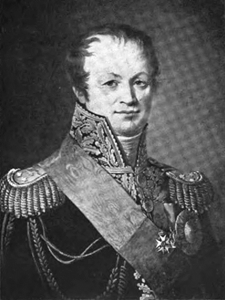General Henri-François-Marie Charpentier

Born: June 23, 1769
Place of Birth: Soissons, Aisne, France
Died: October 14, 1831
Place of Death: Oigny, France
Arc de Triomphe: CHARPENTIER on the south pillar
Pronunciation:
Henri-François-Marie Charpentier first joined the army in August of 1791 when he volunteered to join the 1st Battalion of National Volunteers of Aisne and was elected a capitaine. The next year he and his unit served in the Army of the North, and then in 1793 he served at the defense of Maubeuge. In February of 1794 Charpentier received a promotion to chef de brigade and then two months later he was appointed the chief of staff to General Desjardin. That autumn he served at the siege of Luxembourg under Hatry where he would remain until the successful conclusion of the siege in June of 1795. Next Charpentier served with the Army of the Sambre and Meuse until September of 1796 when he was assigned to the 17th military division.
In 1798 Charpentier was initially employed in the Army of England before being sent to the Army of Holland and then the Army of Italy. In March of 1799 he joined Hatry's division, and the next month he was promoted to général de brigade. Next Charpentier joined Victor's division and then in June he fought at the Trebbia where he was wounded in the lower belly. Two months later he joined Grouchy's division and then fought at the Battle of Novi . The next year Charpentier was initially commanding the 15th military division before he joined the Army of the Reserve and then the Army of Italy.
During the years of peace that followed, Charpentier served as chief of staff of the French troops stationed in the Cisalpine Republic. A promotion to général de division arrived in 1804 and Charpentier continued to work as the chief of staff of troops in Italy. In 1806 when Prince Eugene arrived as Viceroy of Italy, Charpentier became his chief of staff. Three years later when Austria invaded Bavaria and Italy, Charpentier took part in the campaign in Italy as chief of staff to Eugene and then served at the Battle of Wagram . The following year he was created a Count of the Empire.
Charpentier remained as Eugene's chief of staff for the campaign against Russia of 1812. That August he was named governor of the provinces at Witepsk, and then during the retreat as the army broke down and was reorganized he became the chief of staff to Marshal Davout.
Having survived the retreat, in 1813 Charpentier was given command of the 36th Infantry Division of Marshal Macdonald's XI Corps for the campaigns in Germany. That May he fought at Lützen, Bischofswerda, and Bautzen. Three months later Charpentier fought at the Battle of Katzbach where he energetically defended the crossing of the Bober, and then in October he fought at Wachau, Leipzig , and Hanau. The following month Charpentier provisionally took over command of XI Corps from Marshal Macdonald and was awarded the Grand Cross of the Order of the Reunion.
Charpentier returned to Paris for the defense of France of 1814. That February he took command of the 7th Division of the Young Guard and he was sent to Fontainebleau where he repulsed the cossacks. The next month Charpentier served at Craonne, Laon, Fère-Champenoise, and Paris before Napoleon's abdication in April.
The restored Bourbons made Charpentier a Knight of Saint Louis and Grand Officer of the Legion of Honor. Furthermore, he was appointed to a commission to reform the military penal code. When Napoleon escaped from exile in 1815 for the Hundred Days, Charpentier rallied to him and was named commander of the 12th military division. After Napoleon's second abdication, the Bourbons put Charpentier on non-activity before exiling him to Switzerland.
Bibliography
Updated July 2014
© Nathan D. Jensen